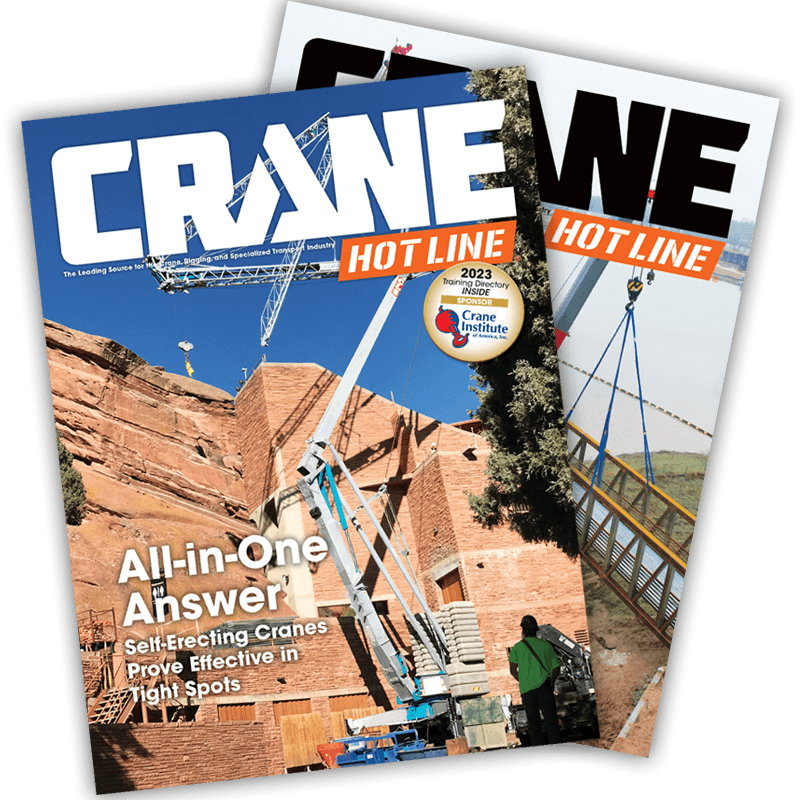Compact Carrydeck Crane Redefines Robust
Enlarge Image
July 13, 2006 -- The 3339 is the latest addition to Shuttlelift's expanding line of industrial cranes that now numbers six models with a variety of boom options. Produced by the Sturgeon Bay, Wis., company, the 3339 is the culmination of suggestions made by customers and dealers on how to improve its predecessor, the 3330. Called an industrial by some, or described as a carry deck crane by others, the 3339 can lift a 9-ton load and rotate it 360 degrees while on outriggers. For a little history on the Shuttlelift Carrydeck, see Part One.

Image 1. The Shuttlelift 3339 carrydeck crane.
The crane also comes with a three-section fully hydraulic main boom that extends to 31 feet. Two jib options include a fixed 12-foot lattice jib and a 12-foot lattice plus 6-foot slide
Enlarge Image
out stinger. Jib locking pins (Image 2) are tapered at each end to make it easier to fit from either side.

Image 2: The jib locking pins are tapered on each end to allow positioning from either end.
It does not take long to realize that crane boasts two distinct attributes: quality and simplicity.
Kurt Minten, Shuttlelift's industrial Carrydeck crane manager, explained that all metal parts are shot blasted, primed and pre-painted before assembly. Once assembled then the crane is run back through for touch up. To limit rust, all pins are zinc plated or stainless steel. Mitten also pointed out that the main chassis structure is a twin box channel design and carriers a five-year structural warranty. Upon my inspection, I didn't find a speck of rust, a sloppy looking weld, or a paint run anywhere on this machine. In addition, where appropriate, steel lines are used to prevent stress, as in Image 3.
Enlarge Image
This is also a very simply designed crane • simple to service, simple to operate, which adds up to a winning combination. Starting with the controls, there are several large valve levers shown in Image 3. These are direct linkage full pressure hydraulic valves that control all boom functions. (Image 4)

Image 3: The use of steel hydraulic lines in flex locations is one example of the unit's quality construction.
Some might argue that this is a little too simplistic. True they require a little more wrist effort than required on a pilot or electro/hydraulic system but you cannot argue with their precise, smooth and very sensitive feeling of control.
Enlarge Image
This feature is important for working in tight space where precise handling is demanded, a typical application for
industrial cranes. Of course, there is nothing easier to trouble shoot or repair than a simple full-pressure hydraulic system.

Image 4: Large direct linkage control levers provide sensitive control.
The most complicated part of this crane, relatively speaking, is the load safety system. A bare bones load indicator (LI) system is standard. But it is possible to step up to a rated capacity limiter (RCL) system. Both systems, supplied by Load Systems International, are wireless. A wired, full feature LMI, provided by Rayco-Wylie, is also available as an option. This unit, which was waiting to be shipped to a refinery, included a Mercotac mercury swivel between the upper and lower, which provides longer service life in this application.
Overall width and height requirements dictate that the
not a problem. The cab (Image 5) is narrow, however, so plus-sized guys might feel a little cramped. The only complaint anyone can have is with the rigid straight back seat. Although I would not want to spend an eight-hour shift in there, that would not be the norm for this type of crane.

Enlarge Image
Image 5: The cab was roomy enough but the seat could be more comfortable.
In Part One, I described the pivoting boom head design. Notice in Image 6 how the boom head position can be altered. To reposition the boom head, all you have to do is lower the block to the ground pull a torpedo-shaped pin and with one arm relocate the head in the desired position and reinsert the pin. Notice the winch that is mounted about bumper high • a great feature for improved load spotting.
All Shuttlelift Carrydeck cranes rated at 10.5 tons and below utilize a front wheel drive system. The 3339 features three steering modes:
Enlarge Image
2 wheel, 4 wheel and crab. The drive axle is provided by Carraro with a MICO-supplied SAHR brake fitted to the drive line's input shaft. Pneumatic tires are standard but both foam-filled and non-marking options are available.

Image 6: Boom head can pivot up to 80 degrees to increase under tip clearance by as much as 10.5 inches.
GM and Cummins are the two engine options. The GM is a 70 hp, 3 liter gas model. Gas/LP is a no charge option. The Cummins is an 85 hp, 3.3 liter turbo-diesel model. The unit I reviewed was equipped with the Cummins diesel engine.
Enlarge Image
Service points on the engine were acceptable although I wouldn't want to have to replace the starter in the field. Sound from the Cummins
engine was minimal thanks in part to a tight engine enclosure, an important feature for the people working around the crane. An optional enclosed cab, equipped on the test unit, also helped to limit noise.

Image 7: Optional electric winch assists in load positioning.
Full pressure operational valves are supplied by Husco. A four-speed forward and reverse synchromesh transmission is supplied by JCB subsidiary I.T.L. This engine-transmission combo produces a fast maximum travel speed of 22.2 mph. To power all the boom and steering functions the engine is coupled to a pair of supply pumps. First in line is a variable displacement piston pump with a through shaft that drives the two-section gear pump.
A base model is listed at $100,500 and the target market has been identified as being primarily rental service. With only a handful of suppliers of these pocket-sized cranes, there are opportunities to carve out and develop a niche market with better than average returns. Whether you call it an industrial crane or a carry deck crane this is a quality product with tons (9 tons to be exact) of ability.
Likes
- The 3339 is able to pick a 9-ton load and swing the boom throughout its 360 degrees of continuous rotation while on outriggers.
- The boom head can be easily pivoted into one of five different positions for a wide range of operating boom angles.
- This model is simple to service and simple to operate.
Dislikes
- The compact cab is room enough, but the rigid straight back seat is less than comfortable.
- Service points on the engine were acceptable although I wouldn't want to have to replace the starter in the field.
Verdict
High quality construction and simple design are paired together with features ideal for the rental market.


